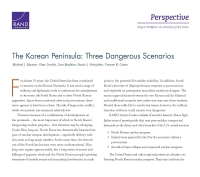by Michael J. Mazarr, Gian Gentile, Dan Madden, Stacie L. Pettyjohn, Yvonne K. Crane
PDF file 8.4 MB
 This perspective summarizes detailed analytical work on the implications of a large, survivable North Korean nuclear force; the challenges of North Korean artillery that can threaten Seoul from the Kaesong Heights; and the issues attendant to a potential mission to secure loose nuclear weapons after a North Korean collapse. We analyze the risks of each contingency on its own as well as how they might interact with one another to create exceptionally dangerous, operationally demanding scenarios. Our work suggests that these three major challenges are complicated by two others—the logistical burden and local chaos of a noncombatant evaluation operation and the potential for third-party intervention, especially by China. Our most important finding is that the United States must develop and work with regional allies to shape a wider range of potential diplomatic and military options to deal with North Korea.
This perspective summarizes detailed analytical work on the implications of a large, survivable North Korean nuclear force; the challenges of North Korean artillery that can threaten Seoul from the Kaesong Heights; and the issues attendant to a potential mission to secure loose nuclear weapons after a North Korean collapse. We analyze the risks of each contingency on its own as well as how they might interact with one another to create exceptionally dangerous, operationally demanding scenarios. Our work suggests that these three major challenges are complicated by two others—the logistical burden and local chaos of a noncombatant evaluation operation and the potential for third-party intervention, especially by China. Our most important finding is that the United States must develop and work with regional allies to shape a wider range of potential diplomatic and military options to deal with North Korea.
This conclusion creates particular implications for the Army, as the core missions involved—including deterring a major war, conducting intensive operations short of major war, and securing weapons of mass destruction in the event of instability—will place massive, perhaps unsustainable, demands on Army capacity and specific high-demand, low-density capabilities. The Army, together with senior Department of Defense and U.S. government leaders, must rethink fundamental assumptions about the strategies and concepts the United States would use in Korean contingencies.
No comments:
Post a Comment